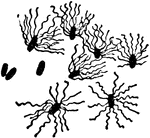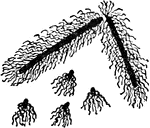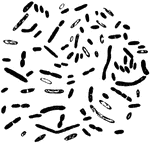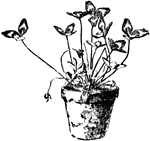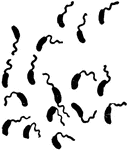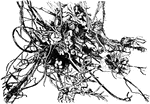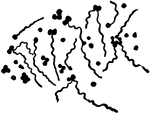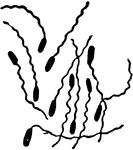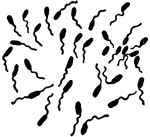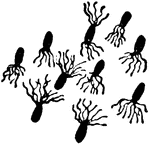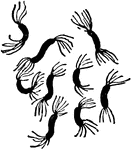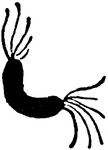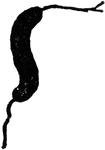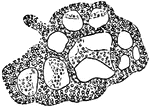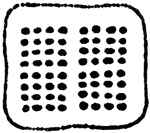Clipart tagged: ‘bacteria’
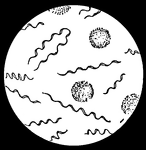
Spirochaeta Obermeieri, Bacteria
Illustration of magnified Spirochaeta obermeieri. This genus of bacteria have "the cells united in long…

Bacilli
"Bacilli, or Rod-Shaped Bacteria. From a culture obtained in antharax, or malignant pustule, of the…
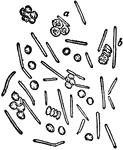
Bacillus Anthracis
"Bacilli mingles with blood-corpuscles from the blood of a guinea-pig; some of the bacilli dividing."…
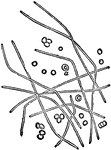
Bacillus Anthracis
"The rodlets after three hours' culture in a drop of aqueous humour. They grow out into long leptothrix-like…
Bacillus Megaterium
"A pair of bacilli actively growing and dividing." — The Encyclopedia Britannica, 1910

Bacillus Megaterium
"A rodlet in this condition (but divided into four segments) after treatment with alcoholic iodine solution."…

Bacillus Megaterium
"Successive stages in the development of the spores." — The Encyclopedia Britannica, 1910
Bacillus Megaterium
"A rodlet segmented in four, each segment containing one ripe spore." — The Encyclopedia Britannica,…
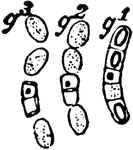
Bacillus Megaterium
"Early stages in the germination of the spores (after being dried several days)." — The Encyclopedia…

Bacillus Megaterium
"Successive stages in the germination of the spore." — The Encyclopedia Britannica, 1910
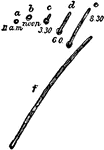
Bacillus Ramosus
"The various phases of germination of spores of Bacillus ramosus, as actually observed in hanging drops…
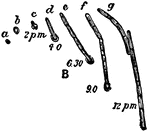
Bacillus Ramosus
"The various phases of germination of spores of Bacillus ramosus, as actually observed in hanging drops…
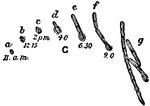
Bacillus Ramosus
"The various phases of germination of spores of Bacillus ramosus, as actually observed in hanging drops…

Bacillus Ramosus
"The various phases of germination of spores of Bacillus ramosus, as actually observed in hanging drops…

Bacillus Subtilis
"Bacillus subtilis, Cohn, and Spirillum undula, Ehrenb." — The Encyclopedia Britannica, 1910
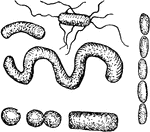
Bacteria
Harmless bacteria so numerous in drinking water that a person often takes a half-million into his stomach…
bacteria and cambric needle
The point of the finest cambric needle, with a particle of dust (above) and bacteria (below) for scale.
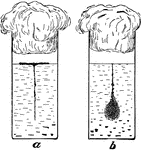
Grown Bacteria
Image A is of bacteria that needs air to grow. Image B is of bacteria that do not need air to grow.
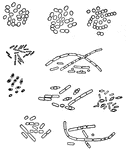
Milk bacteria
"Different Kinds of Milk Bacteria. It is not uncommon for a large number of person to be poisoned from…

Dromedary, two-humped camel
A cud-chewing animal of the Old World, especially adapted by nature to travel waste deserts with scarcity…

Clostridium
"Germination of spore of Clostridium butyricum—the axis of growth coincides with the long axis…
Cocci
"A chair of cocci of Leuconostoc mesenterioides, with two "resting spores," i.e. anthrospores." —…

Bacteria Growth
"Showing the Effect of Variations in Temperature on Bacteria Growth. a, a single bacterium; b, its progeny…

Molds, yeast, and bacteria
"Showing the Comparative Size of Molds (a), Yeast (b and c), and Bacteria (d)." — Blaisedell,…
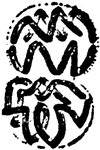
Myconostoc
"Colonies of Myconostoc enveoped in diffluent matrix." — The Encyclopedia Britannica, 1910

Myconostoc
"Colonies of Myconostoc enveoped in diffluent matrix." — The Encyclopedia Britannica, 1910

Myconostoc
"Colonies of Myconostoc enveoped in diffluent matrix." — The Encyclopedia Britannica, 1910

Louis Pasteur
"This picture is based upon a photograph of a painting which has won great fame during recent years.…
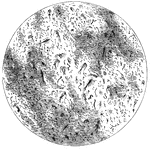
Protozoans
"Their bodies consist either of aa simple elementary cell, with its contents, or of an aggregation of…
Rodlet
"A motile rodlet with one cilium and with a spore formed inside." — The Encyclopedia Britannica,…
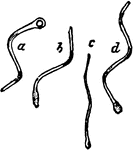
Schizomycetes
"Spore-formation in Vibrio-like (c) and Spirillum-like (a, b, d) Schizomycetes." — The Encyclopedia…

Spirillum
"Spirillum containing many spores (a), which are liberated at b by the breaking up of the parent cells."…
Spore
"Long rod-like form containing a spore (these are the so-called "Kopfchenbacterien" of German authors)."…
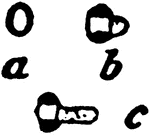
Spore
"Germination of the spore of the hay bacillus—the axis of growth of the germinal rodlet is at…

Spores
"Various stages in the development of the endogenous spores in a Clostridium — the small letters…

Tumbler
A tumbler containing a piece of potato. It is covered with cotton. This is used to grow bacteria.
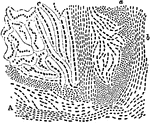
Zoogloea
"Mixed zoogloea found as a pellicle on the surface of vegetable infusions; it consists of various forms,…
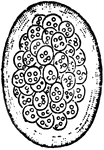
Zoogloea
"Egg-shaped mass of zoogloea of Beggiatoa roseo-persicina (Bacterium rubescens of Lankster); the gelatinous…
